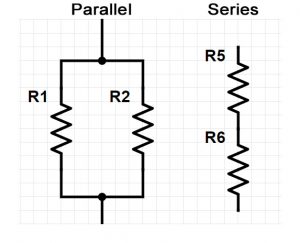There are some handy mathematical tools one can use to simplify circuits that follow from Kirchoff’s Laws. These are parallel and series combinations of components as depicted below. Parallel and series combinations of components can be replaced by single equivalent components.

Resistors
![]()
![]()
![]()
Let’s do an example. Combine the resistors in the circuit below and determine the equivalent resistance.

R1 is in parallel with R2. We denote this with the symbol “//”, R1//R2. Find the equivalent ressitance of the parallel combination.
R1//R2 = 100 // 50 = (100^-1 + 50^-1)^-1 = 33.33 Ohms
Now, R3 is in series with the parallel combination that we just determined the equivalent resistance for. So, add the series combination to get the final answer.
R3 in series with R1//R2: 200 + 33.33 = 233.33 Ohms.

Capacitors
Capacitors are the opposite of resistors. They add when in parallel and reduce in series.
![]()
![]()
![]()
Inductors
Inductors combine like resistors do. Series inductors add, parallel inductors reduce.
![]()
![]()
![]()
Impedances can be Combined in the Same Ways
Impedance expressed as functions of the Laplace variable “s” can be combined in the same way. We will do some examples after we go into impedance in a bit more depth.
Next: Impedance
